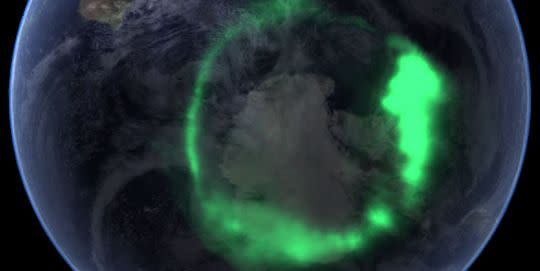Scientists Are Getting Kinda Anxious About a Pothole in Space

The Earth’s magnetic field protects us, and our orbiting tech, from the worst effects of the Sun’s energetic rays.
In a region called the South Atlantic Anomaly, however, the magnetic field is significantly weaker than over the rest of the planet.
NASA is tracking the anomaly, and researchers believe it may have popped up in our sky before.
Earth’s magnetic field is incredibly important to life on our planet. Beyond allowing for compass navigation and displaying the Aurora Borealis way up north, it is responsible for shielding us from the worst effects of the Sun’s rays. A little bit of Sun, we need—a lot would have some serious negative impacts.
Thankfully, we do have a magnetic field. But there’s a bit of a problem: Our magnetic field has a dent in it—what ScienceAlert calls a “pothole in space.”
It’s called the South Atlantic Anomaly (SAA), and it’s not a physical dent. It’s a region in the skies between South America and Africa where our magnetic field is weaker than it is around the rest of the planet. This weakness isn’t life-threatening—it would have to be way more significant to threaten the planet’s surface—but it is an issue for the craft we’ve launched into orbit.
Objects like satellites and other spacecraft reside within our magnetic field as they orbit the Earth. As such, they still benefit from its protection. Take that away, and you get a mess of potential technical difficulties—from small glitches to data loss and serious damage of important components—caused by too much exposure to high energy particles from the Sun.
It’s enough of an issue that those monitoring spacecraft that pass through the SAA often just power the craft down before they enter the region. As such, NASA has been keeping a close eye on this dent for a number of ears now, trying to figure out how it behaves, what’s causing it, and if it’s a sign that things are about to get a lot worse.
The SAA seems to be caused a huge reservoir of very dense rock deep underground called the African Large Low Shear Velocity Province. The biggest contributor to the creation of Earth’s magnetic field is the movement of molten metal in the outer core of our planet, and the African Large Low Shear Velocity Province disrupts that flow, weakening the overall magnetic field as a result.
So far, it at least seems like the region isn’t some kind harbinger of doom—it doesn’t look like we’re losing our magnetic field any time soon. But it could mean we have something to brace for. Some researchers theorize that the SAA is an indication that the Earth’s magnetic field is about to flip (which can happen, though over the course of hundreds of thousands of years), which would most likely have serious consequences for our electronics and communications systems.
But there’s still a lot we don’t understand about this anomaly, especially regarding its behavior. For example, a study from 2016 discovered that the SAA is drifting slowly northwest, and in 2020, it was announced that researchers had discovered the region was splitting into two smaller regions, each centered on an especially weak point.
Even though we still have a lot of questions about SAA, we think we know one thing: this isn’t the first time it’s popped up. In 2020, researchers released a paper suggesting that the SAA just pops up every so often, with occurrences dating back to 11 million years ago. This would indicate we’re not, in fact, looking at the first signs of a flip at all, but some other less-world-altering event that has happened many times in the past. So, even though a dent like this may seem scary, it’s probably something life on Earth has survived before.
NASA will continue to monitor the SAA until we really and truly understand the dent in our sky. Until then, we may just have to keep turning our satellites off and turning them on again.
You Might Also Like

